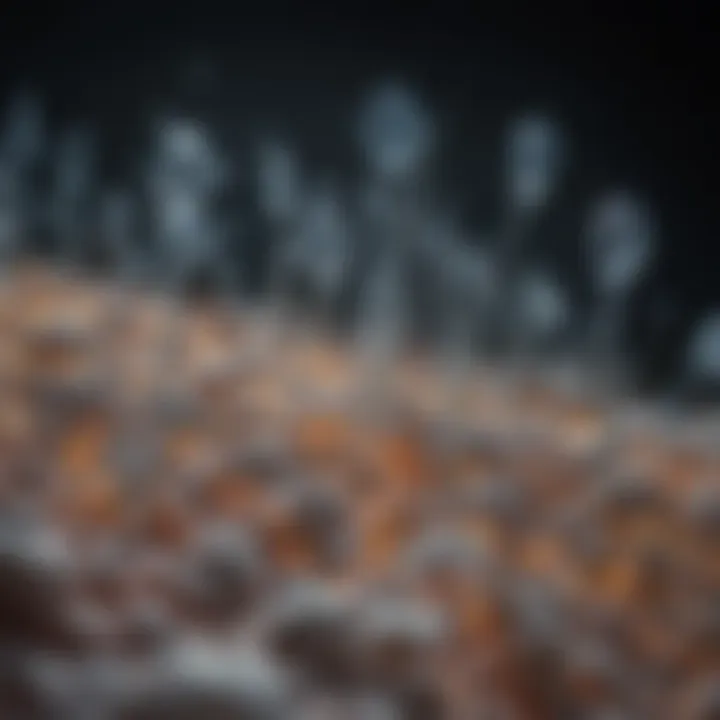Exploring Phototherapy: Mechanisms and Applications


Intro
Phototherapy stands at the intriguing intersection of science and healing, leveraging light as a tool for medical intervention. In a world where technology continuously reshapes medical practices, understanding how light can pivot health outcomes represents an exciting frontier. This article will take a closer look at the myriad ways phototherapy influences therapies across a range of conditions. With light playing a pivotal role, one must ponder the complexities underlying its effectiveness, safety, and the rapid growth of its applications.
Article Overview
Purpose of the Article
This article aims to unpack the mechanisms of phototherapy, elucidating how different wavelengths of light interact with biological systems to foster healing. We will venture beyond the mere technicalities, delving into the broader implications that phototherapy holds for various medical disciplines.
Relevance to Multiple Disciplines
Phototherapy's relevance extends across multiple fields—dermatology, psychiatry, and even oncology. By exploring this multifaceted treatment approach, we aim to bridge gaps between various disciplines, ultimately fostering a more integrated understanding of phototherapy’s role in modern medicine.
Research Background
Historical Context
The roots of phototherapy trace back thousands of years, with ancient civilizations recognizing the healing properties of sunlight. Egyptians, for instance, used the sun’s rays for their curative potential, a practice that laid the groundwork for contemporary approaches. However, the modern understanding began to crystallize in the 19th century when scientists started to investigate light's effects on human health systematically. The advent of the blue light therapies in the 20th century for skin conditions marked a significant breakthrough, showcasing how specific light wavelengths could impact cellular healing processes.
Key Concepts and Definitions
Understanding the key terms is essential for grasping the intricate dynamics of phototherapy. Here are a few essential concepts:
- Phototherapy: A medical treatment that involves exposure to light to alleviate various conditions. It harnesses specific light wavelengths for therapeutic effects.
- Wavelengths: Light exists in various wavelengths, each with different biological effects. For example, ultraviolet (UV) light, visible light, and infrared are prominent in phototherapy.
- Photosensitivity: A condition where skin reacts adversely to light, often a consideration in phototherapy applications.
"Light is life, and it weaves through the tapestry of our health, influencing both mind and body."
"Light is life, and it weaves through the tapestry of our health, influencing both mind and body."
By dissecting these concepts, readers will be better prepared to navigate the succeeding discussions surrounding the mechanisms, applications, and implications of phototherapy.
Preface to Phototherapy
Phototherapy stands as a multifaceted approach in the medical realm, leveraging the healing properties of light to address a variety of conditions. Its significance in contemporary medicine cannot be overstated, as it bridges the gap between traditional treatment methods and innovative solutions tailored to modern needs. This method has gained traction not only for its efficacy but also for its less invasive nature compared to other therapies. The exploration into phototherapy enables both practitioners and patients to understand its potential and the science underpinning it, leading to more informed healthcare decisions.
Definition and Overview
At its core, phototherapy involves the use of specific wavelengths of light to treat medical conditions. This treatment modality can vary significantly in technique and application, often categorized into three primary types: ultraviolet (UV), visible, and infrared light. Depending on the condition being treated, the choice of light—whether it's used to reduce inflammation, promote healing, or even affect mood—plays a pivotal role. Its significance is particularly pronounced in dermatological treatments, mental health management, and pain relief therapies.
In essence, phototherapy stimulates natural biological processes, prompting an array of physiological responses that can lead to symptom alleviation or healing. Researchers continue to investigate how light interacts with cellular structures, deepening the understanding of its mechanisms and expanding the scope of its applications.
History and Evolution
The roots of phototherapy stretch back centuries, though its modern application has evolved dramatically since its inception. Initially, ancient civilizations used sunlight as a basic healing practice, recognizing its benefits long before the science caught up. The advent of the 20th century heralded significant advancements, particularly with the discovery of ultraviolet light's effects on skin disorders.
In the 1930s, doctors began to employ UV light to manage conditions such as psoriasis and eczema, setting a precedent for future explorations into light-based therapies. The introduction of devices like the UVA and UVB lamps marked a pivotal shift, allowing for controlled exposure that optimized treatment outcomes.
The field has advanced rapidly over the past several decades, with researchers and clinicians continuously seeking novel light applications. Technological innovations, such as light-emitting diodes (LEDs) and targeted laser therapies, have opened new doors, facilitating precision in treatment approaches that were once thought impossible. As new findings emerge, phototherapy continues to carve its place in the pantheon of legitimate medical practices.
"History repeats itself, but in every repetition, there lies a lesson to be learned. The evolution of phototherapy exemplifies this notion, reflecting how ancient practices have reshaped modern medicine."
"History repeats itself, but in every repetition, there lies a lesson to be learned. The evolution of phototherapy exemplifies this notion, reflecting how ancient practices have reshaped modern medicine."
In summary, understanding phototherapy not only enriches one’s knowledge of medical treatments but also underscores the importance of light in fostering healing and enhancing the quality of life across various health domains.
Mechanisms of Phototherapy
Understanding how phototherapy works is crucial for grasping its potential in treating various medical conditions. The mechanisms underlying this treatment method are diverse and involve complex biological interactions. These mechanisms not only form the foundation of phototherapy but also highlight its benefits and considerations in clinical practice. Essentially, the efficacy of any light-based treatment hinges on an intricate interplay between biological systems and light.
Biological Basis
Cellular Responses to Light
Light exposure induces specific cellular responses that can lead to therapeutic effects. When skin cells are exposed to certain wavelengths of light, they can activate various metabolic processes. This means that the skin isn't just sitting there; it reacts actively. For instance, ultraviolet light can stimulate the production of vitamin D, which is crucial for skin health and immune function. These responses also extend to photoreceptors within cells, which play a role in signaling pathways that promote healing and regeneration.
A key characteristic of cellular responses to light is their specificity. Different wavelengths invoke different responses. For example, blue light is known to be effective in reducing acne by targeting bacteria in the skin, while red light may enhance collagen production. The diversity of these responses inherently makes them beneficial for a range of conditions, from dermatological to overall skin health.
However, there are disadvantages. Overexposure can lead to skin damage, which emphasizes the need for controlled and well-monitored treatments. Therefore, it's essential to balance these benefits against potential risks.
Phototransduction Pathways


Phototransduction refers to the process by which light is converted into cellular signals. This mechanism is vital for understanding how light affects physiological processes. In human skin, various phototransduction pathways can regulate cellular activity, influencing functions like diurnal rhythms and skin repair.
One prominent aspect of these pathways is the role of specific chromophores in skin cells. For instance, certain pigments absorb specific light wavelengths, triggering a cascade of biochemical reactions. Understanding these pathways can help optimize treatment protocols by tailoring light parameters to achieve desired outcomes.
Nevertheless, these pathways are not without complexities. Different skin types or conditions may respond variably, which necessitates a nuanced approach to treatment that takes individual variability into account.
Types of Light Sources
Phototherapy isn't limited to one type of light; different sources are employed to maximize outcomes. Each type serves specific purposes based on the condition being treated.
Ultraviolet Light
Ultraviolet (UV) light plays a significant role in phototherapy, particularly for skin disorders like psoriasis. By penetrating the outer layer of skin, it helps reduce inflammation and excessive cell production—essentially mitigating conditions that involve skin thickening or scaling.
A major strength of UV light is its ability to target affected skin directly with relatively lower doses compared to other treatments, reducing systemic side effects. However, prolonged exposure heightens the risk of skin cancer and premature aging. It's a powerful tool but must be wielded with caution.
Visible Light
Visible light therapy is gaining traction in treating conditions like acne and wound healing. This light spectrum is considered safer than UV and has been shown to have fewer side effects. A unique characteristic of visible light is its ability to penetrate skin layers without causing damage to DNA, making it a preferred option for younger individuals or those with heightened sensitivity.
On the flip side, the efficacy of visible light can be somewhat limited, as it typically requires more extended treatment durations compared to UV light therapies. In some cases, patients may experience a delayed onset of results, which can be discouraging.
Infrared Light
Infrared light enters even deeper into the skin and is commonly used for pain relief and inflammation reduction. This light therapy can enhance circulation and promote healing in tissues, which can be beneficial post-surgery or for chronic pain conditions.
The unique feature of infrared light is its non-intrusive nature; it generates warmth without causing burns or discomfort. However, not everyone feels comfortable with this method, and its effects can vary by individual, depending on skin type and condition.
Interaction with Skin
Understanding how light interacts with skin is essential for maximizing phototherapy benefits.
Skin Layer Structure
The skin is composed of multiple layers, each serving different functions. The outermost layer, the epidermis, is crucial for light therapy because it is the first point of contact for the wavelengths. Each layer has its own properties and thickness that can affect how light penetrates and is absorbed.
A key aspect of the skin's structure is its barrier function, which can limit the effectiveness of certain therapies. Light that doesn’t penetrate deeply enough may not invoke the desired biological response, hence the importance of choosing the right wavelength. However, improper handling or excessive treatments could disrupt this barrier, leading to complications.
Effect on Cellular Activity
Light not only activates metabolic pathways but also modulates cellular activity crucial for healing. For instance, exposure to certain wavelengths can enhance fibroblast function, which is vital for collagen synthesis. Increasing collagen improves skin elasticity and reduces the signs of aging or damage, contributing to overall skin health.
Yet, too much light can also throw cellular processes into disarray. Cells may react by undergoing apoptosis, or programmed cell death, which can be detrimental. The challenge lies in finding that sweet spot where the light is effective but not harmful.
Applications of Phototherapy
The applications of phototherapy have significantly expanded in recent years, making it an essential area of exploration in both clinical and research settings. These applications range from skin disorders to mental health treatments and pain management, showcasing the versatility and potential that phototherapy offers. Understanding these applications allows healthcare professionals and researchers to better leverage light-based treatments for various conditions.
Dermatological Conditions
Psoriasis Treatment
Psoriasis is a chronic skin condition marked by red, flaky patches that can cause both physical discomfort and emotional distress. The treatment of psoriasis through phototherapy is noteworthy due to its high efficacy, particularly with ultraviolet light (UV) therapy. This approach works by slowing down the rapid growth of skin cells, which is the primary issue in psoriasis.
One of the key characteristics of psoriasis treatment via phototherapy is its ability to provide significant relief while minimizing systemic side effects compared to traditional medications. This makes it a popular choice among patients and practitioners alike. A unique feature of this treatment modality is its ability to be tailored to individual patient needs, allowing for various types of UV light—such as narrowband UVB or PUVA (psoralen plus UVA)—to be utilized based on the severity of the condition and individual skin responses.
However, like any treatment, it comes with disadvantages. Potential long-term risks, including an increased chance of skin cancer due to UV exposure, are important considerations that need to be evaluated within the context of treatment. Thus, while effective, it also requires careful patient selection and rigorous monitoring.
Acne Management
Acne management through phototherapy has gained traction as a complementary approach alongside traditional treatments. Light-based therapies focus on reducing acne-causing bacteria on the skin while also addressing inflammation. Blue light therapy, in particular, is renowned for its effectiveness in targeting Propionibacterium acnes, the bacteria responsible for acne.
This method boasts a notable aspect: it often leads to fewer side effects than chemical treatments, making it a beneficial option for those who experience irritation from topical medications. Its unique feature lies in the ability to deliver results relatively quickly; many patients notice improvements after just a few sessions.
However, certain patients may find that the efficacy is not uniform, leading to variability in treatment outcomes. The necessity for multiple treatment sessions and the requirement for ongoing maintenance therapy can also present challenges for some individuals.
Mental Health Disorders
Seasonal Affective Disorder
Seasonal Affective Disorder (SAD) is a form of depression that typically corresponds with seasonal changes, primarily in winter months when natural sunlight is limited. Phototherapy for SAD has become an invaluable tool for mental health professionals, as it helps improve mood and overall well-being through exposure to bright light, typically through specially designed lamps.
The ability of phototherapy to increase serotonin levels and support circadian rhythm regulation is a significant advantage of this treatment. This key characteristic contributes to its status as a beneficial choice for many patients struggling with seasonal depression. Moreover, the use of light therapy is convenient; it can often be incorporated into a daily routine without the need for medication.


Despite its effectiveness, some patients may experience dizziness or eye strain if they utilize the light incorrectly. Additionally, results can take time, requiring consistent use over weeks to notice substantial benefits.
Anxiety and Depression Management
Anxiety and depression management through phototherapy reflects contemporary understanding of how light can influence our mental states positively. Light therapy helps to alleviate symptoms by mimicking the sunlight that our bodies crave, thus helping in managing stress and improving mood.
The unique characteristic of this application lies in its adaptability; it can be used in conjunction with other treatment modalities, such as cognitive therapy or pharmacotherapy, making it a holistic choice. The fact that it is non-invasive and easy to integrate into a patient’s lifestyle adds to its appeal.
However, not all individuals respond to light therapy in the same way. There's a certain unpredictability involved, often requiring adjustments in the treatment plan. Additionally, while many benefit from it, some may find it less effective or experience side effects like sleeplessness or agitation at the outset.
Pain Management
Chronic Pain Conditions
Chronic pain conditions often leave patients searching for relief and can greatly reduce quality of life. Phototherapy has emerged as a promising option for pain management, particularly with the use of infrared light, which penetrates deeper tissues to promote healing and reduce inflammation.
This application demonstrates a key characteristic: its ability to provide relief without the heavy reliance on pain medications that can come with numerous side effects. The unique feature of using light to address pain is its dual action—reducing inflammation while promoting healing at the cellular level, making it a beneficial ally in the fight against chronic pain.
Nonetheless, chronic pain conditions are complex and individualized. What works for one patient may not do the trick for another. The variability in patient responses to light therapy is a notable disadvantage, requiring clinicians to remain flexible in their treatments.
Post-Surgical Recovery
In the realm of post-surgical recovery, phototherapy serves as a powerful tool to help accelerate healing and reduce discomfort. Light therapy can enhance blood circulation, stimulate cellular activity, and aid in reducing inflammation, contributing significantly to faster recovery times after surgery.
The key characteristic of this application lies in its ability to decrease the risk of complications often associated with surgical procedures, such as infection or prolonged pain. This aspect makes it a popular and advantageous choice for practitioners looking for ways to optimize patient recovery processes.
However, there is the consideration of varying degrees of response to light therapy among individuals, and not every patient may be suitable for this treatment. Additionally, some may find it challenging to adhere to the recommended therapy schedules, which could impact overall effectiveness.
Effectiveness of Phototherapy
Understanding the effectiveness of phototherapy is crucial in assessing its role within modern medicine. The ability of light to treat various conditions has garnered attention from healthcare providers and patients alike. In this section, we will explore critical elements related to the effectiveness of this treatment modality, focusing on the evidence derived from clinical studies and meta-analyses, as well as its comparative benefits versus other treatment options.
Clinical Evidence
Research Studies
When we dive into research studies related to phototherapy, the emphasis largely lies in the collective findings that illuminate its effectiveness across various applications, from dermatological conditions to mental health disorders. A key characteristic of these studies is the systematic approach taken by researchers to evaluate outcomes. By rigorously analyzing treatment results, researchers contribute not only to the existing medical knowledge but also pave the way for future advancements.
One unique feature of these studies is the extensive variety of methodologies used—from randomized controlled trials to observational studies. This diversity allows for a broad spectrum of data that can address specific questions about phototherapy. However, a downside can arise when studies utilize small sample sizes or short durations, introducing questions about the generalizability of the findings. In sum, while research studies are invaluable in showcasing the benefits of phototherapy, they are equally responsible for identifying limitations that warrant further exploration.
Meta-Analyses
Meta-analyses extend the findings of individual research studies, amalgamating their results to derive more robust conclusions. This methodology is heavily relied upon in the discourse surrounding phototherapy effectiveness. The main strength of meta-analyses is their ability to synthesize a large volume of research, offering a comprehensive perspective on treatment efficacy.
Notably, the key characteristic of meta-analyses is their capacity to resolve conflicting results found in smaller studies. By consolidating data, they help in establishing clearer guidelines for practitioners. However, one must note that the quality of the included studies directly impacts the credibility of the meta-analysis. If the studies are flawed, the analysis can lead to misleading conclusions. Overall, integrating findings from multiple studies enhances our understanding of phototherapy, making this a compelling avenue for further examination.
Comparative Efficacy
Phototherapy vs. Pharmacotherapy
When we consider phototherapy compared to pharmacotherapy, it's crucial to understand the different dimensions each treatment adds to patient care. A significant point of comparison lies in the side effects associated with pharmacotherapy, which can range from mild to severe. On the other hand, phototherapy generally exhibits a lower incidence of side effects, making it an appealing option for many patients.
The acute nature of light-based treatments brings about a distinctive advantage as well—it often yields rapid results, especially in skin conditions such as psoriasis. Although pharmacotherapy has its merits, particularly in systemic diseases, the less invasive nature of phototherapy provides a less burdensome alternative for patients seeking effective treatment with minimal complications. Nevertheless, one drawback is that phototherapy often requires more frequent visits to a clinic, compared to the convenience of taking medications at home.
Long-Term vs. Short-Term Outcomes
The dialogue around long-term and short-term outcomes of phototherapy is imperative. While many patients experience immediate relief from symptoms, the sustainability of these results is an area of active inquiry. Short-term outcomes often showcase rapid improvements; however, questions remain about the longevity of these benefits.
Risks and Safety Considerations
Phototherapy, while being a promising treatment method for a variety of conditions, is not without its risks. Understanding the potential pitfalls and adhering to safety measures is essential for healthcare practitioners and patients alike. Addressing these aspects ensures that the benefits of phototherapy outweigh the risks, enabling effective healing while minimizing adverse effects. This section delineates the risks associated with phototherapy, emphasizing the importance of safety protocols to safeguard patient health.
Potential Side Effects
Skin Reactions
Skin reactions represent an important concern when it comes to phototherapy. These can range from mild erythema to more severe conditions, depending on the individual's skin sensitivity and the phototherapy method employed. Some patients may experience immediate reactions such as redness or swelling, making it pivotal for practitioners to monitor any initial signs.
A key characteristic of skin reactions is that they can often be temporary; however, if they persist, they could indicate a more serious underlying issue. For many patients, skin reactions can deter them from continuing treatment. This aspect contributes significantly to the overall topic because it underscores the need for clinician-patient communication about possible side effects. If a patient understands that mild reactions can occur and that there are strategies to manage them, they may feel more comfortable proceeding with therapy.
The unique feature of skin reactions is their variability. Each patient is different in how their skin responds to treatment, which can be advantageous in tailoring therapy to the needs of that individual. However, it also introduces a disadvantage, as predicting how each patient will react can be challenging.
Long-Term Risks


Long-term risks associated with phototherapy can include skin aging, increased risk of skin cancer, and alterations in pigmentation. With repeated exposure to light over extended periods, especially UV radiation, there is a legitimate concern that cumulative effects may lead to significant skin issues. Understanding these risks plays a central role in determining how to proceed with phototherapy safely.
The distinguishing feature of long-term risks is that they might not manifest immediately. This latency can create a false sense of security among patients who may think that they are safe because they aren't experiencing immediate side effects. Yet the potential for harm amplifies over time without proper vigilance.
In terms of advantages, awareness of long-term risks can encourage stricter adherence to safety guidelines, prompting both patients and providers to engage in discussions about the frequency and duration of treatments.
Guidelines for Safe Use
Establishing robust guidelines for the safe use of phototherapy is crucial in minimizing risks. These parameters help ensure that patients receive the most effective and safest care possible.
Patient Selection
Choosing the right candidates for phototherapy is fundamental. Not all patients may benefit equally from this treatment modality. Factors such as skin type, medical history, and specific conditions dictate whether phototherapy could be advantageous. The unique aspect of patient selection lies in its personalized nature.
A key characteristic of this process is the careful screening of potential candidates. This might mean utilizing questionnaires or conducting thorough examinations to ascertain suitability. Understanding which patients might be at higher risk of complications helps in formulating an effective treatment plan that avoids unnecessary harm.
The distinctive feature is that it can foster a collaborative relationship between the healthcare provider and the patient, where informed choices are made. However, the downside is that it might limit access for some patients who could benefit from phototherapy but do not fit typical selection criteria.
Monitoring Protocols
Monitoring protocols are an essential safety measure in phototherapy. This involves regular check-ups to evaluate the patient’s response to treatment, ensuring that any adverse effects are promptly identified and managed. These protocols contribute significantly to maintaining a balance between efficacy and safety.
A prominent characteristic of monitoring protocols is their systematic approach; they often incorporate a schedule of evaluations aligned with the treatment progress. This organized method enhances the overall safety for patients receiving therapy, allowing for modifications in treatment as needed to mitigate risks.
The unique aspect is the proactive nature of these protocols that can lead to early detection of any problems, fostering a safer treatment environment. Conversely, it can potentially be a cumbersome process for both patients and providers if patients are not committed to attending follow-up appointments, which may leave them vulnerable to avoidable complications.
"The success of phototherapy hinges not just on the light itself, but also on the vigilance and proactive measures taken to ensure patient safety."
"The success of phototherapy hinges not just on the light itself, but also on the vigilance and proactive measures taken to ensure patient safety."
In summation, the discussion of risks and safety considerations surrounding phototherapy is integral to understanding its broader implications. By delving deeply into side effects, long-term risks, and safety guidelines, practitioners, patients, and researchers can foster a more informed approach to this light-based treatment, maximizing benefits while minimizing potential harm.
Future Directions in Phototherapy
The landscape of phototherapy is constantly evolving, and the future promises intriguing possibilities that can impact how we understand and utilize this treatment modality. It’s essential to stay abreast of emerging trends and new technologies that have the potential to refine our approach to light-based treatments. By investing in the latest developments, we can enhance patient outcomes and explore novel avenues for therapy.
Emerging Technologies
Advancements in Light Devices
Advancements in light devices are one of the key areas driving the future of phototherapy. These newer devices, equipped with cutting-edge technology, offer unparalleled precision in delivering therapeutic light. A notable feature of these devices is their ability to customize wavelength settings, allowing practitioners to tailor treatments according to individual patient needs. This characteristic is particularly beneficial for addressing specific conditions with accuracy.
One significant advantage is the adaptability of these devices for different therapeutic modalities. An example includes combining various light spectrums to maximize treatment efficacy for skin disorders. However, the cost of these advanced devices can be a drawback, limiting accessibility for some healthcare settings.
Targeted Light Therapies
Targeted light therapies represent a focused approach within the broader realm of phototherapy. What sets these therapies apart is their ability to concentrate light on specific areas of the body, thereby minimizing exposure to surrounding tissue. This precision can lead to improved treatment outcomes with fewer side effects.
The use of localized light applications allows practitioners to treat conditions like localized psoriasis or acne with greater efficiency. A unique feature of targeted therapies is their integration with latest imaging technologies, enabling real-time monitoring during treatment. This innovative strategy is advantageous as it allows for immediate adjustments based on patient response. However, challenges such as treatment time and patient comfort remain concerns that need addressing.
Potential Research Areas
Investigating New Indications
The exploration of new indications for phototherapy is a promising research area that can expand the horizons of this treatment. As researchers delve into understanding how light interacts with various biological processes, new applications may surface. For instance, studies may reveal that varying wavelengths could effectively treat conditions previously deemed unsuitable for light therapy.
A salient characteristic of this research direction is its potential to unearthed synergistic effects when combined with other treatment modalities. This could create integrated therapeutic strategies, offering comprehensive care for patients. The exploration of new indications might face hurdles such as lengthy research validation processes, yet it holds the promise of broadening the adoption of phototherapy.
Enhancing Treatment Protocols
Enhancing treatment protocols is essential to ensure that phototherapy is not only effective but also safe for patients. This involves refining existing guidelines and establishing best practices based on real-world data. A key feature of this approach includes the development of standardized protocols tailored to specific conditions.
By enhancing the protocols, health professionals can ensure that treatments are both consistent and adaptable to evolving research findings. The advantage here is twofold; it ensures patient safety while optimizing the therapeutic potential of light. However, as new practices emerge, continuous education for practitioners becomes crucial to ensure successful implementation.
Finale
Drawing together the threads of this exploration into phototherapy, we find ourselves at an important juncture. This article has detailed not only the mechanisms by which light can lead to therapeutic changes in biological systems, but also its varied applications across skin conditions and psychological disorders, to name a few. The significance of phototherapy lies in its fundamental principle: harnessing the power of light as a valid treatment modality in modern medicine.
In summarizing the key points, it’s essential to underscore the versatility of phototherapy. From its definitive role in managing dermatological issues like psoriasis and acne to its contributions in mental health settings, the breadth and depth of light therapy are commendable. However, to fully appreciate its potential, one must consider the intricate balance between its efficacy and the possible risks involved. Careful consideration of patient selection, continuous monitoring, and adherence to safety guidelines can significantly mitigate these risks.
Summary of Key Points
- Phototherapy operates on biological principles that induce cellular responses through light exposure.
- Different types of light—ultraviolet, visible, and infrared—serve specific therapeutic functions, making understanding their roles crucial for practitioners.
- Applications span multiple disciplines, including dermatology and mental health, emphasizing the broad utility of this treatment modality.
- Empirical evidence supports its effectiveness, though comparative efficacy with traditional pharmacotherapy should always been taken into account.
- Potential side effects, while manageable, necessitate a vigilant, patient-centric approach to treatment.
The Broader Implications of Phototherapy
Looking beyond individual treatments, the impact of phototherapy raises essential questions about the future of healthcare. It suggests a paradigm shift towards non-invasive therapies that minimize reliance on pharmaceuticals. As we delve deeper into personalized medicine, phototherapy stands as a prime candidate for incorporation into diverse treatment regimens tailored to individual needs.
Moreover, emerging technologies in phototherapy hold the promise of expanding capabilities even further. Innovations such as targeted light therapies can pave the way for more efficient treatment protocols, optimizing outcomes for patients. With continued research, it’s likely that new applications will arise, broadening the horizons of this light-based approach in unconventional yet crucial areas of health science.



